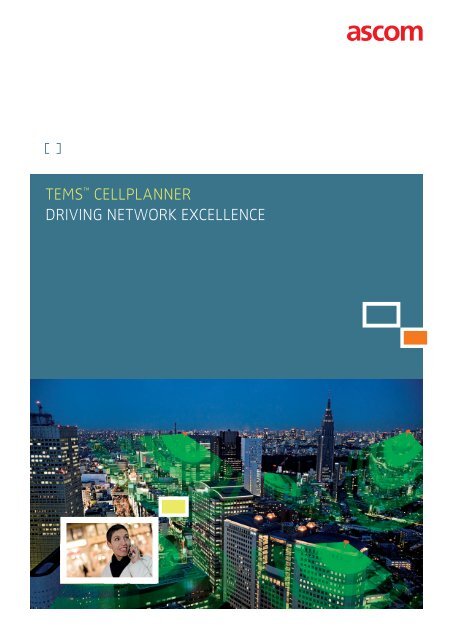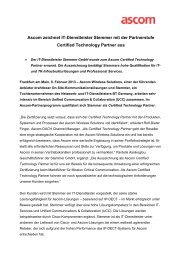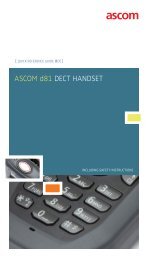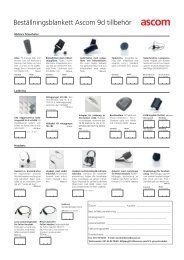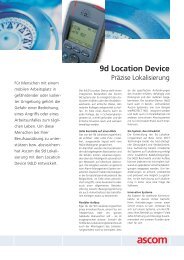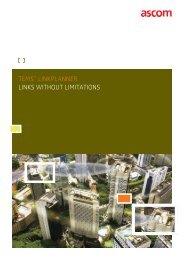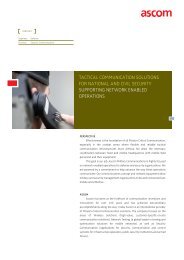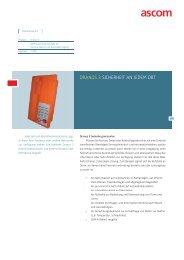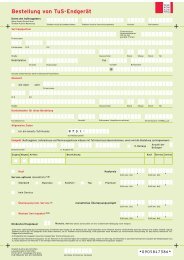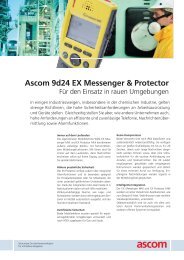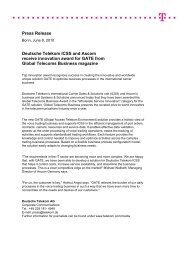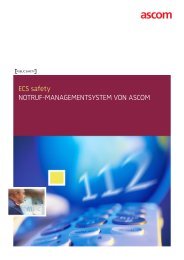Ascom_TEMS CellPlanner 9.1_Product_Offering
Ascom_TEMS CellPlanner 9.1_Product_Offering
Ascom_TEMS CellPlanner 9.1_Product_Offering
You also want an ePaper? Increase the reach of your titles
YUMPU automatically turns print PDFs into web optimized ePapers that Google loves.
<strong>TEMS</strong> CELLPLANNER<br />
DRIVING NETWORK EXCELLENCE
2 <strong>TEMS</strong> CELLPLANNER <strong>9.1</strong><br />
PLANNING AND OPTIMIZATION OF WIRELESS NETWORKS<br />
<strong>TEMS</strong> <strong>CellPlanner</strong> is an advanced<br />
tool for designing, planning, and<br />
optimizing 2G, 2.5G, 2.75G, 3G, and<br />
LTE networks. It provides superior<br />
planning and optimization<br />
capabilities to save time and money<br />
during network deployment.<br />
Powerful, versatile tool<br />
Providing full support for voice and data services in WCDMA, GSM,<br />
WiMAX, and LTE, <strong>TEMS</strong> <strong>CellPlanner</strong> meets the needs of today’s complex<br />
radio networks. It can be used in all phases of a radio network’s lifecycle,<br />
from early planning to the most complex optimization. Because we under-<br />
stand the RF network planners’ concern for accuracy in their network designs,<br />
<strong>TEMS</strong> has developed proven algorithms within <strong>TEMS</strong> <strong>CellPlanner</strong> to help en-<br />
sure the proper number of sites and increase capacity in the network.<br />
<strong>TEMS</strong> <strong>CellPlanner</strong> provides:<br />
▪ Multi-technology and multi-service network support<br />
▪ Outstanding large network support<br />
▪ Advanced handling of drive measurement data<br />
▪ Detailed modeling of the network and accurate algorithms<br />
▪ Advanced Monte Carlo simulations<br />
▪ Optimization features to utilize network investments<br />
▪ Automatic Frequency Planning<br />
▪ Automatic Cell Planning<br />
▪ Unique database solution and easy administration<br />
▪ Scripting support and flexible import/export
GENERAL FEATURES<br />
Easy and flexible setup<br />
<strong>TEMS</strong> CELLPLANNER <strong>9.1</strong><br />
Flexible system configurations allow <strong>TEMS</strong> <strong>CellPlanner</strong> to provide an<br />
efficient working environment. Operators can choose a stand-alone con-<br />
figuration for easy planning and optimization in the field, and database<br />
installation is never required on the client PC. However, the database server<br />
configuration allows multiple-user teams to share planning data and<br />
simultaneously work on common projects. Users can work offline and then<br />
synchronize the project with the database upon returning to the office. The<br />
team approach is regulated by a system of security features for safe data<br />
handling.<br />
Platform and GIS<br />
<strong>TEMS</strong> <strong>CellPlanner</strong> is built on the latest Java architecture and is de-<br />
signed for class-leading accuracy and speed in planning and optimization.<br />
It can be customized to satisfy the needs of every customer, and new func-<br />
tions can be added quickly. Open interfaces enable connection to external<br />
data sources for easy data exchange. The JPython scripting console com-<br />
bines with both the flexible import/export features and the Customized<br />
Attributes feature which allows storage of imported statistics (including<br />
drop calls rate and call setup success rate). This data is displayed through<br />
symbols, colors, and the best server plot. Different thresholds can be set to<br />
provide the user with a powerful toolbox for automation and adaptation.<br />
<strong>TEMS</strong> <strong>CellPlanner</strong>’s fully integrated GIS is tailored for cell-planning tasks.<br />
<strong>TEMS</strong> <strong>CellPlanner</strong> is designed to accommodate large-scale projects by mini-<br />
mizing memory usage and maximizing performance. The true Multi Resolution<br />
Raster (MRR) support makes it possible to mix maps with different resolu-<br />
tions, create and display large plots, and very quickly zoom in and out.<br />
Propagation modeling<br />
<strong>TEMS</strong> has worked extensively with propagation model developers and<br />
fully understands the value of particular models. <strong>TEMS</strong> <strong>CellPlanner</strong> includes<br />
the 9999 Model, an implementation of the Okumura-Hata Model. It also<br />
supports the Urban Model, which combines the Half-screen Model that gen-<br />
erates pathloss above rooftops, and the Recursive Microcell Model for cal-<br />
culating propagation between buildings. Traditional Okumura-Hata and<br />
Walfisch-Ikegami RF Models are supported as well.<br />
3
4<br />
<strong>TEMS</strong> CELLPLANNER <strong>9.1</strong><br />
Drive-test measurement integration<br />
<strong>TEMS</strong> <strong>CellPlanner</strong> offers advanced support for import of drive-test<br />
measurement data. Several different data formats can be matched auto-<br />
matically to the cell configuration in <strong>TEMS</strong> <strong>CellPlanner</strong>, including <strong>TEMS</strong> <br />
Investigation native format. The data can be used for tuning propagation<br />
models and puncturing, among other purposes. With the Automatic<br />
Measurement Integrator (AMI), it is possible to re-use and refine collected<br />
measurement data automatically. An AMI database is built up by consecu-<br />
tive drive-test measurements as it stores the “unmasked” pathloss values,<br />
allowing use of the data even if antenna changes take place. This enables<br />
the user to use both predicted and measured signal strength to improve<br />
the accuracy of pathloss predictions.<br />
Automatic Sector Model Tuning<br />
In addition to automatic tuning of a propagation model for an area, the<br />
Automatic Sector Model Tuning (ASMT) feature optimizes each sector’s<br />
prediction model individually. Based on the AMI database, the ASMT feature<br />
uses all the AMI pathloss data to tune the prediction models per sector.<br />
ASMT automatically selects which sectors to tune based on user-defined<br />
thresholds.<br />
2G, 3G, and LTE co-planning and optimization<br />
<strong>TEMS</strong> <strong>CellPlanner</strong> facilitates detailed co-planning and optimization of<br />
2G, 3G, and LTE networks, from site and common antenna systems to de-<br />
tailed neighbor planning. The included algorithms consider realistic mobile<br />
soft handover behavior with pilot signal strength and handover thresholds<br />
for WCDMA networks.<br />
Data can be imported from live GSM and WCDMA systems to <strong>TEMS</strong><br />
<strong>CellPlanner</strong>. Changes are then automatically calculated in the tool, and new<br />
values exported back to the live system. By this method, <strong>TEMS</strong> <strong>CellPlanner</strong><br />
has the unique capability to efficiently support the full range of optimization<br />
activities.<br />
Demographic Maps<br />
Demographic data refers to a certain population's characteristics as<br />
used for government, marketing, or opinion research. Demographic Maps<br />
in <strong>TEMS</strong> <strong>CellPlanner</strong> are used to ensure efficient traffic spreading for various<br />
services. The data is available in MRR format enabling import, editing, and<br />
creation of reports.
LTE FEATURES<br />
LTE support<br />
<strong>TEMS</strong> CELLPLANNER <strong>9.1</strong><br />
<strong>TEMS</strong> <strong>CellPlanner</strong> supports LTE, the new worldwide standard for mobile<br />
broadband. <strong>TEMS</strong> <strong>CellPlanner</strong> offers the possibility to model LTE networks<br />
containing eNodeBs (LTE RBSs) with sectors, cells, antenna branches,<br />
antennas, feeder cables, and TMAs. The tool also provides a flexible LTE<br />
frequency band editor which allows the user to define any LTE frequency<br />
band and carrier desired.<br />
The LTE module also offers Automatic Cell ID Planning (PCI Planning),<br />
IRAT Neighbor planning and optimization for GSM and WCDMA, LTE Fixed<br />
Subscribers, support for 2x2 MIMO, Tx Diversity, and SIMO. <strong>TEMS</strong> <strong>CellPlanner</strong><br />
enables users to select different channel models and user velocities, as well<br />
as different antenna configurations and transmission modes for the<br />
downlink.<br />
LTE analysis<br />
LTE Monte Carlo analysis functions in <strong>TEMS</strong> <strong>CellPlanner</strong> comprise down-<br />
link and uplink Best Server, Interference and Traffic analysis. <strong>TEMS</strong> <strong>CellPlanner</strong><br />
performs several random trials, using a pseudo-random distribution to spread<br />
the terminals over the map for each trial. The outputs of the analysis are<br />
quality and data rate plots and reports.<br />
5
6 <strong>TEMS</strong> CELLPLANNER <strong>9.1</strong><br />
GSM FEATURES<br />
2G and 2.5G simulation support<br />
<strong>TEMS</strong> <strong>CellPlanner</strong> offers full support for GSM technologies including<br />
GPRS and EDGE Evolution. The advanced RF bearer concept makes it pos-<br />
sible to analyze complex traffic cases simultaneously, both for single and<br />
multiple technologies and frequency bands. <strong>TEMS</strong> <strong>CellPlanner</strong> supports<br />
Hierarchical Cell Structure, OL/UL cell structure, and any type of frequency<br />
hopping including fractional load concept (synthesized hopping). A com-<br />
prehensive collection of plots and reports is available to ensure that maxi-<br />
mum network performance can be achieved. GPRS/EDGE is also fully sup-<br />
ported with flexible traffic modeling and several methods of analyzing<br />
network performance.<br />
Automatic Frequency Planning (AFP)<br />
An advanced AFP module for planning and optimizing multi-band GSM<br />
networks has been developed for <strong>TEMS</strong> <strong>CellPlanner</strong>. The module reduces the<br />
frequency re-use pattern to a minimum and saves valuable frequency<br />
resources. AFP provides ad-hoc planning options giving more flexibility to<br />
frequency plans.<br />
BSIC, HSN, and MAIO optimization<br />
<strong>TEMS</strong> <strong>CellPlanner</strong> includes automatic parameter optimization of BSIC,<br />
HSN, and MAIO plans. The optimization algorithms in these features con-<br />
sider assigned frequencies, the interference matrix, and site synchronization<br />
when determining the optimal solutions.<br />
Live interference import<br />
Interference tables are used for optimizing a frequency plan and for<br />
quality analysis. The tables are created using <strong>TEMS</strong> <strong>CellPlanner</strong>, or imported<br />
as Inter Cell Dependency Matrix (ICDM) files from a live system using OSS.
WCDMA FEATURES<br />
WCDMA support<br />
<strong>TEMS</strong> CELLPLANNER <strong>9.1</strong><br />
<strong>TEMS</strong> <strong>CellPlanner</strong> features an advanced and accurate WCDMA analysis<br />
engine. Full support is offered for Evolved HSPA (HSDPA/EUL) and AMR.<br />
The advanced Monte Carlo Simulator provides flexible allocation of<br />
convergence criteria, cell-based uplink noise convergence, cell-based uplink<br />
noise and downlink power convergence, and user-based uplink noise and<br />
downlink C/I convergence.<br />
<strong>TEMS</strong> <strong>CellPlanner</strong> helps increase capacity in the network. Soft handover<br />
can be displayed in graphical plots as well as in sector-by-sector statistical<br />
reports. The user can set up traffic cases for WCDMA with the help of a<br />
flexible bearer and service modeling capability. To further improve simulation<br />
accuracy, live traffic can be imported on a cell-by-cell basis. <strong>TEMS</strong> <strong>CellPlanner</strong><br />
allows the user to display and print many different coverage- and capacity-<br />
related plots. It also supports storing of plot snapshots that later can be<br />
compared with new plots.<br />
Evolved HSPA support<br />
<strong>TEMS</strong> <strong>CellPlanner</strong> supports modeling of the latest releases of HSPA, of-<br />
fering higher throughputs (up to 42 Mbps in the downlink and 11.8 Mbps in<br />
the uplink), combined 2x2MIMO and 64QAM, and support for 2ms TTI in the<br />
uplink. <strong>TEMS</strong> <strong>CellPlanner</strong> enables the accurate modeling of HSPA capabilities<br />
for high-speed data users by employing random user distribution and simu-<br />
lation of HSPA-related radio channels in both uplink and downlink. In addition,<br />
priority may be given to R99 traffic in traffic simulations, which produces a<br />
more accurate simulation. This advanced approach results in more-realistic<br />
HSPA network coverage, quality, and capacity figures compared to simpler<br />
algorithms that operate only on DL power estimates for HSDPA.<br />
Mobile TV – MBMS<br />
Mobile TV – Multimedia Broadcast and Multicast Services (MBMS) can be<br />
planned using <strong>TEMS</strong> <strong>CellPlanner</strong>. MBMS channels can be defined in the Monte<br />
Carlo Simulator, and their coverage and performance analyzed in connection<br />
with other traffic existing in the cells. This can help operators in securing the<br />
quality and capacity needed for the introduction of Mobile TV services.<br />
Automatic scrambling code optimization<br />
<strong>TEMS</strong> <strong>CellPlanner</strong> supports automatic scrambling code optimization by<br />
scrambling code groups. The optimization criteria include received pilot<br />
signal quality, signal-to-interference ratio, and reserved scrambling codes,<br />
among others.<br />
7
www.ascom.com/networktesting<br />
<strong>Ascom</strong> Network Testing Inc.<br />
1943 Isaac Newton Square<br />
Reston | VA | 20190-5006 | USA<br />
www.ascom.com/networktesting<br />
Automatic Cell Planning (ACP)<br />
The ACP Module is an integrated part of the solution, developed<br />
exclusively for <strong>TEMS</strong> <strong>CellPlanner</strong>. It can be used for rollout, optimization, and<br />
operations. Its unique design improves usability, performance, and analysis<br />
accuracy. The ACP Wizard provides fast setup of the project.<br />
All cells are optimized individually based on the user’s requirements<br />
for coverage, quality, and capacity versus cost for each change. The radio<br />
parameters that can be optimized are pilot power, azimuth, and electrical<br />
and mechanical down tilt. The optimization can be done for a whole project<br />
or a smaller region. With the preplanned area concept, areas surrounding<br />
the optimization area are protected from bad coverage and bad quality.<br />
Without these preplanned areas, the optimization area could be extremely<br />
good, but the surrounding areas could suffer in quality or coverage.<br />
The AMI and ASMT features create valuable input to the Automatic<br />
Cell Planning (ACP) module. The output from the ACP module is a list of<br />
changes in prioritized order to minimize disturbance in the network during<br />
the implementation.<br />
WIMAX FEATURES<br />
WiMAX support<br />
<strong>TEMS</strong> <strong>CellPlanner</strong> can plan for mobile and fixed position subscribers,<br />
define WiMAX channel settings and terminals, calculate and display through-<br />
put, interference, utilization, or coding schemes, and automatically generate<br />
and display neighbor lists.<br />
The PUSC (Partial Usage of Subcarriers) feature is simulated in the<br />
WiMAX module. This feature enables users to further reduce interference,<br />
increasing capacity and throughput on the cell edge.<br />
For more information about <strong>TEMS</strong> <strong>CellPlanner</strong> or other tools in the<br />
<strong>TEMS</strong> portfolio, visit us on the web at: www.ascom.com/networktesting.<br />
03.2010 © <strong>Ascom</strong> 2010. All rights reserved. <strong>TEMS</strong> is a trademark of <strong>Ascom</strong>. All other trademarks are the property of their respective holders. | 287 01-FAP 901 0982 Uen | Photo: Fotograf Paulina and Fotograf Mijac AB


